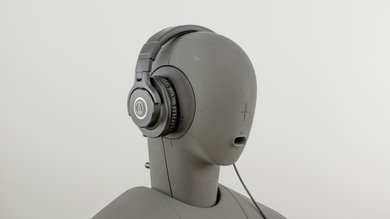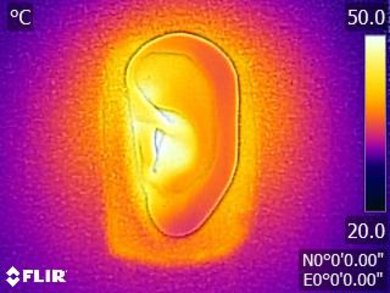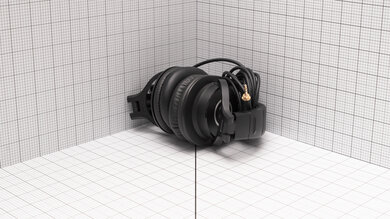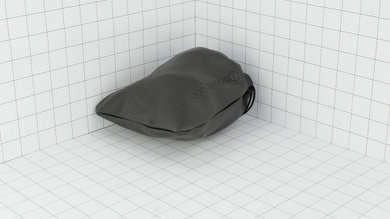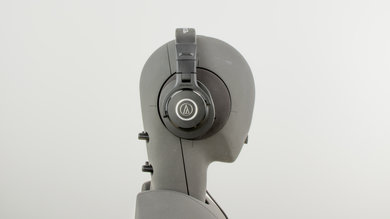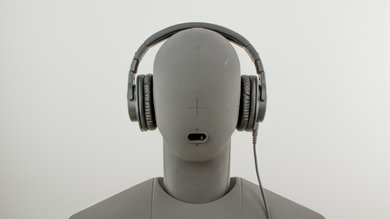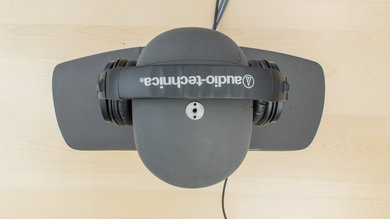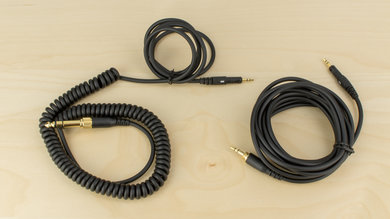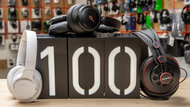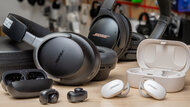The Audio-Technica ATH-M40x are decent headphones with outstanding, studio-quality sound. They feel sturdy and are fairly comfortable but offer no control options for your audio. They also only provide passive isolation, which might not be enough to block the noise of some listeners' commutes.
Our Verdict
The Audio-Technica M40X deliver a reliable bass, mid, and treble response for neutral listening. They don't have much soundstage because of their closed-back design, but their well-balanced sound will still satisfy most listeners.
-
Good audio reproduction.
-
Sturdy build.
-
Poor isolation.
-
No buttons or audio controls.
Not ideal for commuting and loud noisy environments. Their passive isolation doesn't block much noise.
-
Good audio reproduction.
-
Sturdy build.
-
Poor isolation.
-
No buttons or audio controls.
Not designed for sports. They're a bit too bulky and unstable to stay put during intense exercises.
-
Good audio reproduction.
-
Sturdy build.
-
Poor isolation.
-
No buttons or audio controls.
Mediocre for office use. They won't block the chatter of a busy office and leak a bit too much for a quiet one.
-
Good audio reproduction.
-
Sturdy build.
-
Poor isolation.
-
No buttons or audio controls.
-
Good audio reproduction.
-
Sturdy build.
-
Poor isolation.
-
No buttons or audio controls.
- 7.5 Neutral Sound
- 4.6 Commute/Travel
- 5.3 Sports/Fitness
- 5.2 Office
- 4.2 Wireless Gaming
- 6.3 Wired Gaming
- 2.0 Phone Calls
Changelog
- Updated Jul 07, 2021: Converted to Test Bench 1.5.
- Updated Feb 07, 2020: Converted to Test Bench 1.4.
- Updated Nov 21, 2019: Converted to Test Bench 1.3.1.
- Updated Nov 21, 2019: Converted to Test Bench 1.3.
- Updated Feb 16, 2018: Converted to Test Bench 1.2.
Check Price
Compared To Other Headphones
See our recommendations for the best over-ear headphones, the best wired headphones, and the best audiophile headphones.
The Audio Technica ATH-M50x are very similar to the Audio Technica M40x, but they have a slight edge over them. They feel a bit sturdier and better-built than the M40x. Both headphones will give you great sound and are also great options for critical listening, but the M50x offer one of the best values on the market due to their great price-to-performance ratio.
The Sony MDR-7506 and the Audio-Technica ATH-M40x are closed-back headphones. The Sony are more consistent among various users and have a repariable design, while the Audio-Technica have a more comfortable and stable fit, and come with two different detachable audio cables.
The Audio-Technica ATH-M40x and the Shure SRH 400 are both closed-back, open-ear headphones with similar performances for critical listening. The Shure are more comfortable and have a slightly more even sound profile, but they lack a bit in the low-bass. The Audio-Technica, on the other hand, have an overemphasized bass, particularly in the high-bass range, which can make them sound muddier.
The Audio-Technica ATH-M40x, while similar in appearance to the Audio-Technica ATH-M20x, have a better overall build quality without exposed wiring on the headphones. They have more room to accommodate ears. They fit with better stability than the ATH-M20x. In the upper bass frequencies, the ATH-M20x provide a more accurate bass response, while the ATH-M40x have a greater lower frequency extension with more thump in your audio. In contrast, the treble range sounds more accurate on the ATH-M40x. The ATH-M40x also have two detachable cables and a pouch, while the ATH-M20x retains a single hardwired cable.
The Beyerdynamic DT 770 PRO are slightly better than the Audio-Technica ATH-M40x. The Beyerdynamic have a slightly more accurate overall sound signature, but they can be slightly too sharp and piercing. On the upside, they're noticeably more durable than the Audio-Technica, thanks to their full-metal frame and large ear cups. If your budget allows it, go for the Beyerdynamic unless you're sensitive to higher frequencies.
The Audio-Technica ATH-M40x and the Sennheiser HD 280 Pro 2016 are both closed-back headphones with reasonably balanced sound profiles. The Audio-Technica are more comfortable, which makes them better suited for long listening sessions. Still, their exaggerated bass and treble ranges can sound quite boomy and even piercing at times. However, they deliver audio more consistently, with less deviation in the bass and treble ranges between listening sessions. The Sennheiser have a much more balanced bass and smoother overall sound but aren't as comfortable.
The Philips SHP9500 and Audio-Technica ATH-M40x are made for different applications. The Philips are more comfortable, breathable, open-back headphones. The sound profile doesn't have as much thump, but their audio is delivered more consistently between wears. On the other hand, the closed-back Philips leak less audio and do a better job of passively isolating you from background sound, although they still don't block out very much noise. They're also more stable.
The Audio-Technica ATH-M40x are better headphones for a neutral sound than the Audio-Technica ATH-M30x from the same lineup. The biggest difference is that the M40x is definitely more neutral in the treble range, where the M30x lack a lot of detail and brightness. The M40x also come with a nice coiled cable, but other than that, they're very similar.
The Audio-Technica ATH-M40x and the Beats Solo Pro have different strengths, and you may prefer one over the other. The Audio-Technica are for audiophiles. They're more comfortable and have a better passive soundstage performance. However, the Beats are better for casual use. They're better built and have an ANC system that can block out a good amount of background noise. They also have a wireless design and an H1 chip, so you can seamlessly pair them with your Apple devices.
Test Results
The Audio-Technica M40X have a very understated studio design that might look a little bland for some. They have an all-black color scheme with silver highlights on the back of the oval ear cups. Their design is very similar to the ATH-M50x. They look good but offer nothing remarkable with their design.
The large ear cups of the ATH-M40x fully encompass the ears and do not apply too much pressure to the head. They also swivel, which makes them easy to adjust. They are more comfortable than the Beyerdynamic DT 770 but the padding used for the headband and ear cups is a little rigid and squeak when moving or adjusting the headphones on your head.
The ATH-M40X, like the ATH-M30X, are decently portable headphones. They are on the larger side of over-ear headphones but fold into a more compact format that will fit in a backpack or handbag but will be too large for most jacket pockets. The thick or very long audio cable is also a bit cumbersome to carry around but unlike the lower-end model of the series are detachable.
The ATH-M40X feel robust and durable. They have a mostly plastic design that's dense and able to handle a fair amount of physical stress. They have a metal frame that reinforces the headband, and the ear cups feel sufficiently sturdy to withstand a few drops without damage. The joints, on the other hand, are susceptible weak points where these headphones could get damaged and may weaken over time.
The Audio-Technica M40x are decently stable on the head. They are not designed for sport, so they will easily slide off your ears while running or jumping. However, for casual listening sessions, they will stay in place even if you put them on, tilted and little further back than usual. The detachable cable is also a plus for stability, as long as you remember to unlock the cable from the ear cups.
Poor isolation. The passive isolation provided by the ear cups does a decent job of blocking treble sound. However, as the frequency lowers, so does the effectiveness of the passive isolation. Their effect below 400Hz is minimal.
Average leakage. These headphones do leak some sound, and the majority of that happens between 500Hz and 4KHz, which is rather broadband. However, the overall leakage is not too loud.
No compatible app.
Comments
Audio-Technica ATH-M40x: Main Discussion
Let us know why you want us to review the product here, or encourage others to vote for this product.
- 32120
Thanks for the thoughtful and well-explained response — I really appreciate the transparency and the respectful tone. It’s good to know how the scoring system is broken down and how limited the weighting is for things like mic controls and RGB (which, fair enough, don’t matter to everyone). I totally understand the need for consistency across test rigs and appreciate the effort to give comparable data. That said, I still think there’s room for improvement when it comes to accessibility considerations — even just a tag or optional note for how passive headphones perform when paired with something like a DAC/amp would go a long way. A lot of gamers in my position rely on that kind of setup out of necessity, not luxury. Also, a future update under TB 2.0 for widely used models like the M40x would be great — especially since it’s still a popular choice for users who value sound clarity over bells and whistles. Thanks again for taking the time to reply so thoroughly. It really does make a difference when feedback feels heard.
No problem!
I passed on your suggestions about testing headphones and DAC/amps to our test designer for headphones.
In the meantime, I suggest checking the impedance and sensitivity of a pair of headphones when choosing headphones that can reach a sufficient loudness for you. Generally, the lower the impedance (if I were you, I’d look for headphones around 32 ohms), the easier it is to drive the headphones to reach whatever the sensitivity level is that’s listed (usually in dB/SPL at 1kHz in either V or mW). The higher the sensitivity level, the louder they can get at 1 kHz when pushed at the listed voltage (or milliwattage, as the case may be), with the listed impedance. We show these in the Electrical Aspects box in the newer Test Bench 2.0 reviews.
For products that aren’t on this test bench, usually the manufacturer will list it. Audio-Technica rates the M40x as 35 ohms with a sensitivity of 98 dB/SPL at 1 kHZ at 1600 mW, so they’re not the most sensitive headphones, but easy to drive, which means your DAC/amp is likely able to push them beyond that 98 dB/SPL. There are online tools that can give you rough estimates, but from what you’ve said, it sounds like you need loud headphones, so keep that in mind if you choose to try one of those calculators in the future. Most headphone amps have plenty of power on tap to drive headphones, but you’ll get a louder dB/SPL output with a low impedance and high sensitivity pair of headphones.
Thanks again for raising your concerns!
- 21010
Thanks for the thoughtful and well-explained response — I really appreciate the transparency and the respectful tone. It’s good to know how the scoring system is broken down and how limited the weighting is for things like mic controls and RGB (which, fair enough, don’t matter to everyone).
I totally understand the need for consistency across test rigs and appreciate the effort to give comparable data. That said, I still think there’s room for improvement when it comes to accessibility considerations — even just a tag or optional note for how passive headphones perform when paired with something like a DAC/amp would go a long way. A lot of gamers in my position rely on that kind of setup out of necessity, not luxury.
Also, a future update under TB 2.0 for widely used models like the M40x would be great — especially since it’s still a popular choice for users who value sound clarity over bells and whistles.
Thanks again for taking the time to reply so thoroughly. It really does make a difference when feedback feels heard.
- 32120
As someone who is half deaf and uses the M40x paired with a Sound Blaster G6, I find your low gaming score very misleading. You’re evaluating these purely on default consumer-gaming features — mic, app support, surround sound — while ignoring what really matters for players like me: sound clarity, directional accuracy, and latency. The M40x delivers sharper, cleaner audio than most “gaming” headsets, especially when paired with a proper DAC/amp. I can hear footsteps, reloads, and subtle movement through walls in games like Siege — something I couldn’t do with overpriced headsets that prioritize fake bass and RGB. Your review doesn’t account for audiophile or accessibility setups, where the M40x completely outperforms traditional headsets. For anyone serious about sound precision, or with hearing issues like mine, your score fails to reflect its real-world value. Please consider revising your testing criteria to better reflect paired setups with external DACs, and not just judge on missing gimmicks like mic controls or software bloat that many gamers don’t even use.
Hey there,
Since you’re primarily concerned with aspects like sound quality with passive headphones, checking verdicts for Neutral Sound, or Audio Reproduction Accuracy on reviews on Test Bench Methodology 2.0 ought to better address your needs.
If you click on the ‘?’ next to a usage score, it’ll show you the breakdown of percentages of the various tests that make up a score for Wired Gaming. The reason I’m mentioning this is because these headphones are on an older methodology, Test Bench 1.5, and some of your feedback doesn’t quite line up with how the scores are compiled: for example, on 1.5, the microphone and noise handling combined only make up 12% of the score breakdown, app is merely 4%, and mic controls are just 1%. We also don’t score RGB functionality at all. In contrast, the verdict score is mainly broken down by various sound quality measures (36.9%), alongside latency (18%), and comfort (18%).
Since these gaming verdicts are aimed mainly at all-in-one gaming headsets, we differentiate them from the Neutral Sound (and Audio Reproduction Accuracy on TB 2.0) score by acknowledging these other features like the app and mic, and reasonably assume that if you’re using passive headphones or don’t need a mic, you’ll look at the applicable tests or verdict scores that directly address what you care about, in this case, sound. Just because you’re using the headphones for games doesn’t mean you don’t care about the sound quality, like anybody else listening to music, so looking at the verdicts and tests you care about is the central advice for navigating the site’s headphones reviews.
It’s fair to point out that we don’t have specific accessibility tests. There are challenges with that, such as the diverse nature and different degrees of people’s hearing impairments, but that doesn’t mean it’s not important to try, that’s true. So, I appreciate that feedback. Our shift towards preference-based sound signatures with more recently updated reviews on TB 2.0 emphasizes that you know better than we do what kind of tuning works best for you, and that’s applicable regardless of whether you have significant hearing loss or nearly perfect hearing. We’ve rolled this out for TB 2.0, so we’re working to improve our reviews and testing by acknowledging differences between people. This review is an older one and hasn’t been updated, though. However, it still scores well for sound quality measurements.
Unfortunately, we don’t have plans at the moment to add a DAC/amp product category, and for the sake of comparability across different pairs of headphones, we strive to measure using the same testing rig. Admittedly, the rig has changed as we’ve improved our testing methods, but the goal is still cross-comparability (at least) on the same test bench. I don’t doubt that with the right setup, the ATH-M40x are solid gaming headphones, though they don’t necessarily need a DAC/amp to drive them, given their impedance and sensitivity, unless you use the DAC/amp to drive them to even higher output volumes to compensate for your hearing impairment.
Thanks for your feedback, and I hope this helps you navigate our reviews with more clarity.
- 21010
As someone who is half deaf and uses the M40x paired with a Sound Blaster G6, I find your low gaming score very misleading. You’re evaluating these purely on default consumer-gaming features — mic, app support, surround sound — while ignoring what really matters for players like me: sound clarity, directional accuracy, and latency.
The M40x delivers sharper, cleaner audio than most “gaming” headsets, especially when paired with a proper DAC/amp. I can hear footsteps, reloads, and subtle movement through walls in games like Siege — something I couldn’t do with overpriced headsets that prioritize fake bass and RGB.
Your review doesn’t account for audiophile or accessibility setups, where the M40x completely outperforms traditional headsets. For anyone serious about sound precision, or with hearing issues like mine, your score fails to reflect its real-world value.
Please consider revising your testing criteria to better reflect paired setups with external DACs, and not just judge on missing gimmicks like mic controls or software bloat that many gamers don’t even use.


